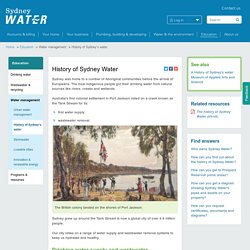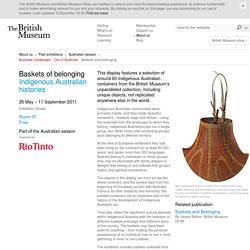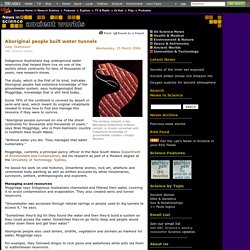

History of Sydney Water. Water supply Another drought in 1901-1902 led to the building of the Cataract, Cordeaux, Avon and Nepean Dams between 1907 and 1935.

Dams were also built to serve Sydney’s south and the Blue Mountains. There was a severe drought again between 1934 and 1942. This prompted the building of Warragamba Dam, which began in 1948 and was completed in 1960. Wastewater system Bondi Wastewater Treatment Plant was built in 1936. The sewerage system was extended in the southern suburbs with sewage flowing to Botany Sewage Farm. Sewage from the northern suburbs flowed to Folly Point Treatment Works. The South Western Suburbs Ocean Outfall Sewer at Malabar was built in 1916, the Wollongong Sewerage Scheme in 1929 and the Northern Suburbs Ocean Outfall Sewer in 1930. In 1936, Bondi Sewage Treatment Plant was built. The first inland schemes were built in 1938 at: Aboriginal Culture. The type of carrier depends on locally-available natural bush plants.

Across northern Australia, trees such as the Banyan (Ficus virens virens), Kurrajong (Brachychiton paradoxum), Grewia, and some Hibiscus species have bark with stringy fibres suitable for teasing out and making into bush string. This string is then woven to create soft dilly bags used as general carryalls. These string bags continue to be made to this day, both for domestic use and for sale to tourists.
In the Kimberley region of north Western Australia, the roots of young boab trees are dug out and stripped to make string, which is then woven into bags. Australian Indigenous tools and technology. Warning.

Australian Stories may contain the names and images of Aboriginal and Torres Strait Islander people now deceased. Australian Stories also contain links to sites that may use images of Aboriginal and Islander people now deceased. The key to Aboriginal and Torres Strait Islander technologies is both their intimate understanding of the natural environment as well as their skills in designing artefacts that were flexible and adaptable. Tools and technology implements Ludo Kuipers, Louis Jupurrula making a 'karli' or boomerang in Lajamanu, a Warlpiri Aboriginal community in the Northern Territory, 1981. Western Australian Museum. Baskets and belonging: Indigenous Australian histories. This display features a selection of around 60 Indigenous Australian containers from the British Museum’s unparalleled collection, including unique objects, not replicated anywhere else in the world.

Indigenous Australian communities were primarily mobile, and they made beautiful containers – baskets, bags and dishes – using the materials from the landscape to which they belong. Indigenous Australians are not a single group, but rather many interconnecting groups, each belonging to different territory. At the time of European settlement they had been living on the continent for at least 60,000 years, and spoke more than 200 languages.
Baskets belong to individuals or family groups; they may be decorated with family designs or designs that belong to and indicate that group’s history and spiritual connections. Ancient Worlds News - Aboriginal people built water tunnels - 15/03/2006. Indigenous Australians dug underground water reservoirs that helped them live on one of the world's driest continents for tens of thousands of years, new research shows.

The study, which is the first of its kind, indicates Aboriginal people had extensive knowledge of the groundwater system, says hydrogeologist Brad Moggridge, knowledge that is still held today. Some 70% of the continent is covered by desert or semi-arid land, which meant its original inhabitants needed to know how to find and manage this resource if they were to survive. "Aboriginal people survived on one of the driest continents for thousands and thousands of years," says Brad Moggridge, who is from Kamilaroi country in northern New South Wales. "Without water you die. They managed that water sustainably. " Moggridge, currently a principal policy officer in the New South Wales Department of Environment and Conservation, did his research as part of a Masters degree at the University of Technology, Sydney.
Related Stories. Australia's water story. The Australian component of the Water exhibition, ‘Australia’s water story’, was added by the National Museum of Australia.

It includes objects from the Museum’s National Historical Collection which help examine the use of water over time and the challenges of variable supply and demand. Australia is the driest inhabited continent, with the most variable rainfall. Water in a dry land Spinifex covers vast areas of arid Australia and is well adapted to a dry climate. Photo: K Thiele, Australian National Botanic Gardens. Australia’s water story is one of adapting to the environment, and adapting the environment to us. Looking at water in nature, there are animals, birds and plants that reflect remarkable adaptation to a dry continent. Small mammals such as the fat-tailed dunnart and kowari obtain all their water from their food. Somehow pelicans, straw-necked ibis, yellow-billed spoonbills and other waterbirds fly huge distances to find water after rainfall. History of Sydney Water. Water supply Another drought in 1901-1902 led to the building of the Cataract, Cordeaux, Avon and Nepean Dams between 1907 and 1935.

Dams were also built to serve Sydney’s south and the Blue Mountains. There was a severe drought again between 1934 and 1942. Good water trick. Finding Water in the Desert - Ray Mears World of Survival - BBC.